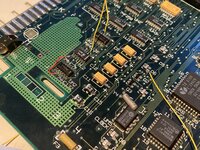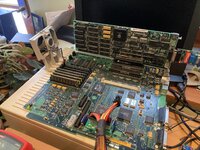Phipli
Well-known member
Yup. Cursed ground plain.A little update: still waiting for caps, but I removed all the old caps without any trouble - my first time doing this. The battery holder was a royal pain, though. I spent an absurd amount of time trying to get the remnants of the old battery holder's negative lead out of the PCB, using the iron, a second iron with a spring-loaded suction, and pliers. I tried every which way pushing, pulling, and heating, but I couldn't dislodge the 2mm piece of the old battery lead that's stuck in the through hole. I had to admit defeat and give up, so attaching the new battery holder is going to require some creativity.
You want to try removing the axial caps on the power plains on a Mac II/IIx.
Hakko solder removal gun has the grunt to remove the solder.
Otherwise, use low temperature solder and mix it with the existing solder. The type of stuff that you get as solder paste with something like 150°C melting point.
Or chipquick if you've got some.





